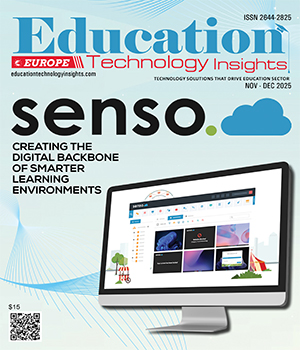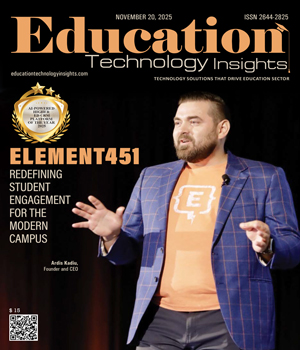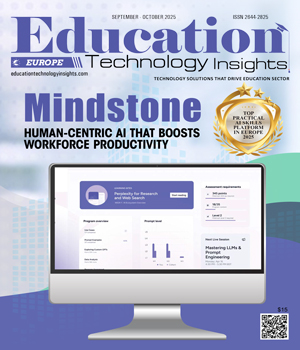THANK YOU FOR SUBSCRIBING
Be first to read the latest tech news, Industry Leader's Insights, and CIO interviews of medium and large enterprises exclusively from Education Technology Insights
Embracing AI to Transform Online Learning
Michael Ciocco, Ph.D., Associate Vice President for Online Learning, Rowan University
 Michael Ciocco, Ph.D., Associate Vice President for Online Learning, Rowan University
Michael Ciocco, Ph.D., Associate Vice President for Online Learning, Rowan UniversityMichael is a distinguished leader at Rowan University, where he manages the Online Learning department, overseeing instructional design, curriculum development, faculty training, and enterprise learning technologies. Passionate about advancing online education, he has been instrumental in shaping Rowan’s digital learning initiatives by integrating technology with pedagogy to foster engaging, high-quality student experiences. Michael earned his Ph.D. in Electrical and Computer Engineering from Rowan’s Henry M. Rowan College of Engineering, with research in artificial intelligence, neural networks, adversarial attacks, and digital image processing. He also teaches in Rowan’s Master of Engineering Management program, supporting adult learners.
“It’s gotten so that I don’t want to teach anymore!” My heart sank as a tenured faculty member, and long-time online course subject matter expert (SME), expressed her frustration with students’ unauthorized use of AI for their classwork.
As the Associate Vice President for Online Learning at Rowan University, I find myself frequently encountering instructors seeking a sense of control with the use of AI growing in the learning environment. Online courses face unparalleled questions with respect to academic integrity, and instructional designers are challenged with developing fair and reasonable solutions for SMEs and students.
Though welcoming an unfamiliar approach is difficult, educators benefit from embracing AI warmly. Student overdependence on AI presents obstacles for online learning, leading some instructors to call for the prevention of further integrating AI into education. However, historically, higher education encourages exploring innovative strategies to support student success. AI’s possibilities are captivating, and we have an opportunity to prepare students for a workforce rapidly adopting such tools.
At my institution, we’re cautiously investigating opportunities to integrate AI into teaching and learning. In an exploration of national trends, we’ve found many universities are trying different approaches, but few have definitive results. Some common institutional AI projects for online learning include student AI literacy initiatives, adoption of AI detectors to combat fraud head-on, and designing assessments to be authentic.
“Embracing AI’s potential to transform teaching and learning while exploring strategies specific to online learning. This is both a presidential initiative and the focus of the online division, where we are seizing opportunities to leverage AI”
Introducing AI Literacy to support ethical student use seems like an obvious choice, but there are some complex points to consider. There is limited research available supporting the effectiveness of AI literacy deployment for the purpose of academic fraud prevention. Moreover, institution-wide AI Literacy projects can be cumbersome, expensive and potentially out of date by the time they are launched. These concerns aside, the training may benefit students by offering a deeper understanding of how to use AI for their own success.
AI detectors hold the promise of a fast solution, but under the surface, they are fraught with issues surrounding incidence of false positives. For this reason, many institutions, including my own, question the use of AI detectors for proof of an academic integrity violation. Anecdotally, I have witnessed one too many false accusations of AI-generated content to have full confidence in their accuracy, often skewed toward non-native English speakers.
Other institutions have leaned into course learning design approaches to combat AI-related academic integrity issues. Many have launched faculty workshops encouraging the use of authentic assessments that emphasize personal engagement or real-world related problems. Unfortunately, this design approach is losing steam as the latest generation of AI platforms, which can personalize to the user, seems to overcome authentic assessments with ease.
More recently, there are glimmers of hope in tools that provide revision and authorship tracking. These tools, while not perfect, offer a reasonable fraud prevention measure that works to keep the student and instructor duly informed of actions taken during assignment authorship. The main goal is to encourage a conversation between the student and instructor about how AI tools were used responsibly to support their work.
At my university, we are embracing AI’s potential to transform teaching and learning while exploring strategies specific to online learning. This is both a presidential initiative and the focus of the online division, where we are seizing opportunities to leverage AI. Our view is that adopting a “wait-and-see” policy or worse, trying to avoid AI in the online classroom altogether, risks not only falling behind peer institutions but, importantly, neglects an opportunity to enhance students’ experiences.
Looking back on my conversation with the SME who felt defeated by her experiences with AI, today I would support her with discovering a new approach that embraces student use of AI in her course design. While I did not have an answer for her then, now I know that students are discovering more use for AI, and that is a curiosity that educators are able to nurture.
Read Also
Navigating Course Map Design
Beyond the Classroom: Supporting Belonging and Wellbeing for International Students
Building Responsible AI Practice Across a University
Designing Engagement That Lasts
Digital Creativity as a Catalyst for Deeper Learning
Protecting Precious Cargo: A Comprehensive Look at School Bus Safety

I agree We use cookies on this website to enhance your user experience. By clicking any link on this page you are giving your consent for us to set cookies. More info

However, if you would like to share the information in this article, you may use the link below:
www.educationtechnologyinsightseurope.com/cxoinsights/michael-ciocco-nid-3438.html






















